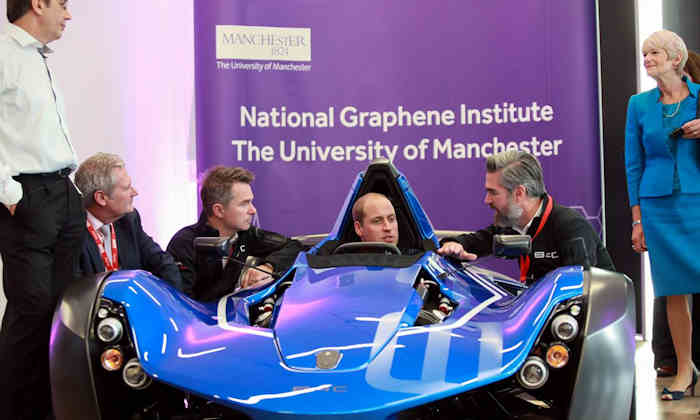Graphene celebrates its first 20 years
22 Oct 2024
How Nobel Prize winning wonder material – isolated with sticky tape in a Friday night experiment – is making a difference to our lives

Graphene – the Nobel Prize winning wonder material discovered with sticky tape as a result of Friday night experiment – celebrates its 20th anniversary today (Tuesday, 22 October).
It was isolated by Professor Sir Andre Geim and Professor Sir Kostya Novoselov, here at our University, in 2004.
Andre and Kostya went on to win the Nobel Prize for their discovery in 2010.
Graphene – the world's first 2D material, thinner than the diameter of a single human hair yet many times stronger than steel, electrically and thermally conductive but also transparent – is helping to address some of our greatest challenges.
Its amazing properties mean it can be applied to transport, medicine, electronics, energy, defence, desalination and more.
From improving the strength and durability of concrete – one of the leading causes of global carbon dioxide, by increasing its service life and reducing cement requirements; to biomedical applications such as targeted drug delivery; to enabling energy storage solutions that can hold renewable energy for longer; to reducing the weight of cars or planes and therefore the energy we need to power them.
There’s also creating a running shoe that delivers 25% greater energy return than standard EVA foams and is far more resistant to compressive wear – a shoe worthy of launching COP27.
Prince William and Catherine – now HRH The Prince and Princess of Wales – were shown some of the incredible applications of graphene with the heir to the throne getting behind the wheel of the world’s first graphene car.
Graphene even opened the refurbished Whitworth art gallery with a bang. Art lover Kostya blew on a graphene switch to set off fireworks, having worked with artist Cornelia Parker to create the switch from taking tiny fragments of graphite from the pencil lead on drawings by Blake, Turner, Picasso and Constable and turning them into graphene.
But what of the next 20 years – and beyond?
In the ultimate serendipity, here in Manchester – a city known for its rain – we are harnessing energy from raindrops. Using nanocapillaries made from graphene, Dr Qian Yang is progressing underpinning research that could lead to the development of a brand-new form of renewable energy.
In addition, brain implants made from graphene will enable precision surgery in diseases such as cancer. Our researchers’ work with INBRAIN Neuroelectronics and funding from the European Commission’s Graphene Flagship project has seen a significant advancement in demonstrating the ability of graphene-based BCI technology beyond decoding and translating brain signals to become a reliable tool.
Use of nanotechnology for early detection of brain disease is being researched by Dr Marilena Hadjidemetriou and her team, part of Manchester’s vibrant 2D materials science community, funded by a €1.5m ERC grant.
Sensors that could pave the way to better diagnosis, monitoring and treatment of respiratory diseases – based on a 2D material called hexagonal boron nitride (h-BN), they are significantly more sensitive and accurate than previous designs.
Membranes with advanced filtration to improve the sustainability of the food and drinks sector, in a project exploring how graphene and other 2D materials-based membranes can be used for more healthy, sustainable, and responsible plant-based food production by newly appointed Royal Academy of Engineering Research Chair, Professor Rahul Nair.
The development of affordable, sustainable, and robust modular smart homes made from recycled products through the Graphene Engineering Innovation Centre’s work with Vector Homes.
Even helping to grow plants and crops without soil by exploring the use of graphene in Gelponics, a sustainable solution for soil-less plant cultivation.
Celebrating 20 wonder years
The University is celebrating graphene’s 20th anniversary with an Instagram takeover and a range of social media content.
And you can hear Andre’s story, including how he and Kostya discovered the wonder material in a Friday night lab session, visit:
Find out more
To find out more about our University’s work on graphene, visit:
